|
Naval Warfare
The old notion that the Hindus were essentially a landlocked people,
lacking in a spirit of adventure and the heart to brave the seas, is
now dispelled. The researches of a generation of scholars have
proved that from very early times the people of India were
distinguished by nautical skill and enterprise, that they went on
trading voyages to distant shores across the seas, and even
established settlements and colonies in numerous lands and islands.
In ancient India, owing to the geographical influence, nautical
shill and enterprise seems to have been best developed in three
widely separated region of the country. These were Bengal, the
valley and delta of the Indus, and the extreme south of the Deccan
peninsula, called Tamilagam.
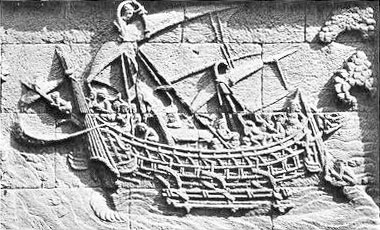
Boat-making and ship-building industries were found in India since
ancient times. In the Vedic period, sea was frequently used for
trade purposes. The Rig Veda mentions "merchants who crowd the great
waters with ships". The Ramayana speaks of merchants who crossed the
sea and bought gifts for the king of Ayodhya. Manu legislates for
safe carriage and freights by river and sea. In some of the earliest
Buddhist literature we read of voyages ‘out of sight’ of land, some
lasting six months or so.
In Kautalya Arthasastra the admiralty figures as a separate
department of the War Office; and this is a striking testimony to
the importance attached to it from very early times. In the Rg Veda
Samhita boats and ships are frequently mentioned. The classical
example often quoted by every writer on the subject is the naval
expedition of Bhujya who was sent by his father with the ship which
had a hundred oars (aritra). Being ship-wrecked he was rescued by
the twin Asvins in their boat.
"There was also extensive intercourse of India with foreign
countries, including the Mediterranean lands and the African
continent, naturally led to piracy on the waters. There then arose
the need for the protection of sea-borne trade, and we are told that
“at the outset the merchant vessels of India carried a small body of
trained archers armed with bows and arrows to repulse the attacks of
the pirates, but later they employed guns, cannon and other more
deadly weapons of warfare with a few wonderful and delusive
contrivances.”
(source:
The Commerce and Navigation of the Ancients In the Indian
Ocean - William Vincent pp. 457). These are probably the beginnings
of the ancient Indian navy.
In the Shanti Parvan (59, 41) of the Mahabharata it is said that the
navy is one of the angas (part) of the complete army. Examples of
ships being used for military purposes are not lacking. When Vidura
scented danger to Kunti’s five sons, he made them escape to the
forest with their mother, crossing the Ganges in a boat equipped
with weapons having the power of withstanding wind and wave.
In the
Dig Vijaya portion of the Sabha parva, it is said that Sahadeva
crossed the sea and brought many islands under his sway after
defeating the Mlecchas and other mixed tribes inhabiting them. If
this be an historical fact the inference is irresistible that he
could not have effected his conquest without the use of boats and
vessels. We read in the Ramayana that Durmukha, a Raksasa, who had
been fired by the impulse of anger at the deeds of Hanuman, offered
his services to Ravana even to fight on the sea.
This is testimony
enough of the use of a fleet for war purposes. There are other
references here and there to ships in the Ramayana. When Hanuman was
crossing the ocean to Lanka, he is compared to a ship tossed by
winds on the high seas. Sugriva speaks of Sumatra, Java and even the
Red Sea, when sending
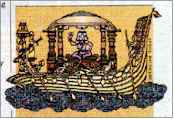 forth his monkey hosts in quest of Sita. forth his monkey hosts in quest of Sita.
The Amarakosa, mentions a number of nautical terms which stand for
ship, anchorage (naubandhana), the helm of the ship (naukarana), the
helmsman (naukaranadhara). That there were ships-building yards in
different parts could be inferred from a significant term
navatakseni occurring in a copper plate grant of Dharmaditya dated
531. A.D.
About 517 B.C. according to Herodotus, Darius launched a maritime
expedition under Skylax of Caryanda to the Indus Delta, and during
Alexander’s time, again, we read of the people of the Punjab fitting
out a fleet. We have the testimony of Arrian to show that the
Xathroi (Kshatri), one of the Punjab tribes, supplied Alexander
during his return voyage with thirty oared galleys and transport
vessels which were built by them.
(source: India and Its Invasion by Alexander p. 156)
In the Manusamhita (Vii. 192), it is laid down that boats should be
employed for military purposes when the theatre of hostilities
abounded in water. Kamandaka (XVI, 50) alludes to naval warfare when
he says:
"By regular practice one becomes an adept in fighting from
chariot, horses, elephants and boats, and a past-master in archery."
Manavadharmasastra refers to sea fights and attests to the use of
boats for naval warfare. The sailor is called naukakarmajiva. Thus
in Vedic, Epic and the Dharmasastra literature we find that naval
warfare is mentioned as a distinct entity, attesting a continuous
naval tradition from the earliest times. Yukti-kalpataru specifies
one class of ships called agramandira (because they had their cabins
towards the prows), as eminently adapted for naval warfare (rane
kale ghanatyaye).
Passing on to other literary evidence, we find in the Raghuvamsa
frequent reference to boats and ships. Raghu in the course of his
digvijaya conquered Bengal which was protected by a fleet (nausadhanotyatan).
In anther place it is mentioned that Raghu marched on Persia through
the land route, and not by the sea route, thereby showing that the
latter was the more common route.
Historian Dr. Vincent A. Smith says that ‘the creation of the
Admiralty department was an innovation due to the genius of Chandragupta.
"The Admiralty as a department of the State may have been a creation
of Chandragupta but there is evidence to show that the use of ships
and boats was known to the people of the Rg Veda. "
(source:
Early History of India - By Vincent Smith p 133).
In the following passage we have reference to a vessel with a
hundred oats.
‘This exploit you achieved, Asvins in the ocean, where
there is nothing to give support, nothing to rest upon, nothing to
cling to, that you brought Bhujya, sailing in a hundred oared ship,
to his father’s house.’
Further on in the Veda, this same vessel is described as a
plava
which was storm-proof and which presented a pleasing appearance and
had wings on its sides. Another reference informs us that Tugra
dispatched a fleet of four vessels (Catasro navah) among which was
the one referred to above. We may infer from these passages that the
Asvins were a great commercial people having their home in a far-off
island, and that their ruler Tugra maintained a fleet in the
interests of his State. There are also other references in the Rg
Veda to show that the ancient Indians were acquainted with the art
of navigation. For instance, Varuna is credited with a knowledge of
the ocean routes along which vessels sailed.
The Baudhayana Dharmasastra speaks of Samudrasamyanam and interprets
it as nava dvipantaragamanam, i.e. sailing to other lands by ships.
This very term occurs in the navadhyaksa section of the Kautaliya
Arthasastra.
The Puranas have several references to the use of ships and boats.
The Markandeya Purana speaks of vessels tossing about on the sea.
The Varahapurana refers to the people who sailed far into the ocean
in search of pearls and oysters. The ships floated daily on the
shoreless, deep and fearful waters of the ocean. We are on firmer
ground when we see in the Andhra period their coins marked with
ships. The ship building activities were great on the east coast,
and the Coromandel coast in particular. From this period to about
15th century A.D. there was a regular intercourse with the islands
of the Archipelago most of which were colonized and also with
ancient America right across the Pacific as testified to us by the
archaeological finds and inscriptions in those parts.
The Pali books of Sri Lanka like the Mahavamsa refers to ocean going
vessels carrying 700 passengers. Such frequent intercourse and
colonization through the ages could not have been effected without a
powerful fleet.

Ships Landing of Prince Vijaya in Sri Lanka - 543 BC from Ajanta
Frescos.
Ajanta painting of a later date depict horses and elephants
aboard the ship which carried Prince Vijaya to Sri Lanka.
(source: India Through the ages - By K. M. Panikkar).
But it is in a later work, the Yuktikalpataru of Bhoja, that we have
three classes of ships - the Sarvamandira, the Madhyamandira, and
Agramandira. The first was called Sarvamandira because it had
apartments all around. In the Sarvamandira were carried treasures,
animals, and ladies of the court. This was the vessel ordinarily
used by kings in times of peace. The Madhyamandira was so called
because the living quarters were situated in the middle. It was a
sporting vessel and generally used in the rainy season. The vessel
of the third kind, the Agramandira, took its name from the
circumstance that the living room was located in front or at the top
of the vessel. The Agramandira was used for distant and perilous
voyages and also sea-fights.
There are also in the Yuktikalpataru other references to vessels.
There are 27 types of ships mentioned here, the largest having the
measurement 276 ft X 36 ft X 27 ft weighing roughly 2,300 tons. The
following passage points to the use of ships in warfare. The line:
naukadyam vipadam jneyam makes it clear that naval expeditions were
common. Under the heading of yanam or march mention is made of
expeditions by land, water and air.
Kautilya remarks:
"Pirate ships (himsrika), boats from an enemy's
country when they cross its territorial limits, as well as vessels
violating the customs and rules enforced in port towns, should be
pursued and destroyed."
It is obvious that the task set forth above
could only be performed by armed vessels belonging to the state.
From this we may conclude that in ancient India ships were employed
in warfare at least as early as the Rig Vedic times. It is an
incontrovertible fact that there was a naval department in Mauryan
times. We have the testimony of Megasthenes that the navy was under
a special officer called the Superintendent of Navigation. This
official was in turn controlled by the Admiralty department. The
officer whom Megasthenes refers to as Superintendent of Navigation
is called Navadhyaksa as already seen, in the Arthasastra.
The Greek
accounts bear testimony to the fact that navigation had attained a
very high development at the times of Alexander's invasion, for we
are told that the invader was able to secure a fleet from the Punjab
at short notice. The Arthasastra lays down some healthy regulations
relating to navigation. Vessels which gave trouble or were bound for
the enemy's country, or transgressed the regulations of port towns
were to be destroyed.
A considerable ship building activity is evident on the west coast
of India also as noted in the Sangam works of the Tamils. South
India carried on political and commercial activities as far as the
Mediterranean in the early centuries of the Christian era and
before. The great Ceran Senguttavan had a fleet under him.
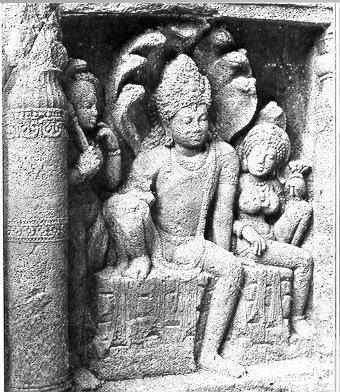
Turning to the history of South India, we have evidence to show that
the country had trade and culture contacts with foreign countries
like Rome in the west and Malay Archipelago and South east Asia in
the east. Yavana ships laden with articles of merchandise visited
the west coast frequently. There was active foreign trade between
Tamil Indian and the outer world at least from the time of Soloman,
i.e. about 1000 B.C. Roman historians refer to the commercial
intercourse that existed between Rome and South India. In the first
century before Christ we hear of a Pandyan embassy to Augustus
Caesar. (refer to Periplus translated by Schoff p. 46).
The Sangam classics point to the profession of pearl-diving and
sea-fisheries on a large scale. We hear of shipwrecks of the early
Tamils saved now and then by Manimekhalai, the goddess of the sea.
(Note: ancient Tamil tradition traces its origins to a submerged
island or continent, Kumari Kandam, situated to the south of India.
The Tamil epics Shilappadikaram and Manimekhalai provide glorious
descriptions of the legendary city and port of Puhar, which the
second text says was swallowed by the sea.
As in the case of Dwaraka,
(please refer to chapter on Dwaraka and Aryan Invasion Theory),
initial findings at and off Poompuhar, at the mouth of the Cauvery,
show that there may well be a historical basis to this legend: apart
from several structures excavated near the shore, such as brick
walls, water reservoirs, even a wharf (all dated 200-300 B.C.), a
few years ago a structure tantalizingly described as a "U-shaped
stone structure" was found five kilometers offshore, at a depth of
twenty-three meters; it is about forty meters long and twenty wide,
and fishermen traditionally believed that a submerged temple existed
at that exact spot. If the structure is confirmed to be man-made
(and not a natural formation), its great depth would certainly push
back the antiquity of Puhar.
Only more systematic explorations along
Tamil Nadu's coast, especially at Poompuhar, Mahabalipuram, and
around Kanyakumari (where fishermen have long reported submerged
structures too) can throw more light on the lost cities, and on the
traditions of Kumari Kandam, which some have sought to identify with
the mythical Lemuria).
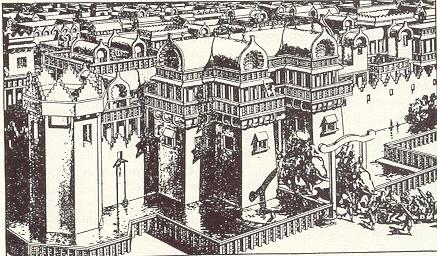
ancient city in India.
We have the account of a Cera King conquering the Kadamba in the
midst of sea waters. The Cera King Senguttuvan had a fleet with
which he defeated the Yavanas who were punished with their hands
being tied behind their backs and the pouring of oil on their heads.
The Cholas also maintained a strong fleet with which they not only
invaded and subjugated Lanka but also undertook overseas
expeditions. Among the conquests of Rajaraja, Lanka was one, and his
invasion of that island finds expression in the Tiruvalangadu
plates, where it is described as follows:
"Rama built, with the aid of the monkeys, a causeway over the sea
and then slew with great difficulty the king of Lanka by means of
sharp-edged arrows. But Rama was excelled by this (king) whose
powerful army crossed the ocean in ships and burnt the king of
Lanka."
Rajaraja also sent an expedition against the Twelve Thousand
Islands, obviously a reference to the Laccadives and Maldives.
Friendly embassies were also sent by the Chola king to China.
From the evidence of the Mahvamsa as well as from a few inscriptions
we are able to gather some information regarding the diplomatic
relations that existed between India and Sri Lanka. We have the
story of Vijaya and his followers occupying the island about 543
B.C. Vijaya was a prince of North India who was banished from the
kingdom by his father. Passing through the southern Magadha country
he sailed to Sri Lanka, according to the Rajavali, in a fleet
carrying more than 700 soliders, defeated the Yaksas inhabiting it,
and settled there permanently.
This story is illustrated in the Ajanta frescoes.

Numerous ships carried the troops of Rajendra to Sri Vijaya and its
dependencies which he conquered. Among the places conquered were
Pannai (Pani or Panei on the east coast of Sumatra), Malaiyur (at
the southern end of the Malay Peninsula), Mappappalam ( a place in
the Talaing country of Lower Burma), Mudammalingam (a place facing
the gulf of Siam), Nakkavaram (the Nicobar islands. Besides, active
trade was carried on between South India and China during this
period.
At the end of the 10th century the Chinese emperor sent a mission to
the Chola king with credentials under the imperial seal and
provisions of gold and piece-goods to induce the foreign traders of
the South Sea and those who went to foreign lands beyond the sea for
trade to come to China.
The facts clearly show that the Cholas maintained supremacy over the
sea and kept a strong and powerful navy which was useful not only
for carrying on extensive commerce with foreign countries but also
for conducting military expeditions. During the days of the
Kakatiyas of Warangal, Motupalle (Guntur District) was the chief
port, on the east coast. Ganapatideva, the Kakatiya ruler,
extirpated piracy on the sea and made the sea safe for commerce with
foreign countries like China and Zanzibar. This policy was pursued
by Rudramba, his daughter.
Vijayanagar kingdom also claimed supremacy over the sea. Since the
days of Harihara I the rulers of Vijayanagar took the title of the
Lord of the Eastern, Western and Southern oceans; and there were 300
ports in the empire. The activities of the Vijayanagar fleet on the
west coast are also referred to by the Portuguese in 1506.
The Vijayanagar kings sent friendly embassies to foreign courts. 'Bukka
I sent an embassy through his chief explainer to the court of Taitsu,
the King Emperor of China, with tributes and large presents, among
which was a stone which was valuable in neutralizing poison.
Accounts of Foreign Travelers to India
Coming to later times we have the account of Hiuen Tsang who notices
a fleet of 3,000 sail belonging to the King os Assam. There is
inscriptional evidence of the possession of a fleet under the
Kakatiyas and the Cholas in South india. Marco Polo testifies to the
huge size and efficient construction of Indian vessels while Yule in
his Cathey refers to Rajput ships en route to China.
Marco Polo, a
famous Venetian traveler who visited India in 13th Century also
visited Thane Port. The first chapter of his book which deals with
India is almost devoted to shipbuilding industry in India. Friar Odoric of Pordenone, an Italian Monk who visited India in 14th
Century, in his account of his voyage across the Indian Ocean, a
mention is made of ships which can carry 700 people.
"Ships of size that carried Fahien from India to China (through
stormy China water) were certainly capable of proceeding all the way
to Mexico and Peru by crossing the Pacific. One thousand years
before the birth of Columbus Indian ships were far superior to any
made in Europe upto the 18th century."
(source:
The Civilizations of Ancient America: The Selected Papers
of the XXIXth International Congress of Americanists - edited Sol
Tax 1951).
Ludovico di Varthema (1503 A. D) saw vessels of 1,000 tons burden
built at Masulipatnam. According to Dr. Vincent, India built great
sized vessels from the time of Agathareids (171 B.C.) to the 16th
century. And no wonder the Portuguese, when they first landed at the
west coast, were carried away by the excellent Indian vessels. Later
still, the Vijayanagar Empire, which had as many as 300 ports, had a
powerful fleet. The naval commander was styled Naviyadaprabhu.
India has a coastline of about 6300 km. Extensive new
archaeological, epigraphical, sculptural and literary material has
been added to our knowledge since the early decades of this century.
Dr. Radha Kumud Mookerji's Book
Indian Shipping - A History of the
Sea-Borne Trade and Marine Activity of The Indians From The Earliest
Times published in 1912 Orient, is the most
comprehensive study of Indian Navigation up to that period.
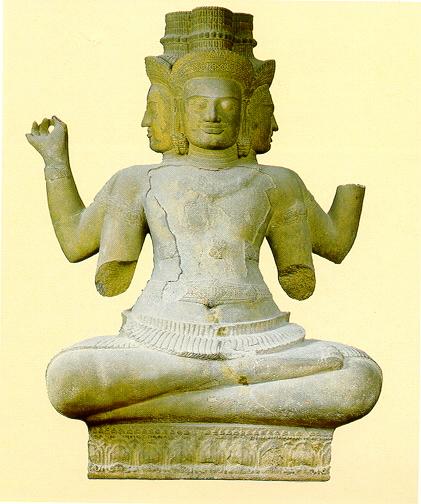
We now
know that many ports on both Eastern and Western Coast had
navigational and trade links with almost all Continents of the
world. There are many natural and technological reasons for this.
Apart from Mathematics and Astronomy, India had excellent
manufacturing skills in textile, metal works and paints. India had
abundant supply of Timber. Indian - built ships were superior as
they were built of Teak which resists the effect of salt water and
weather for a very long time.
"The art of Navigation was born in river Sindhu 6000 years ago. The
very word navigation is derived from Sanskrit word Nav (or Nav-ship)
Gatih."
Lieut. Col. A.Walker's paper: "Considerations of the affairs of
India" written in 1811 had excellent remarks on Bombay-built ships.
He notes,
"situated as she is between the forests of Malabar and
Gujarat, she receives supplies of timber with every wind that
blows."
Further he says, "it is calculated that every ship in the
Navy of Great Britain is renewed every twelve years. It is well
known that teakwood built ships last fifty years and upwards. Many
ships Bombay-built after running fourteen or fifteen years have been
brought into the Navy and were considered as stronger as ever. The
Sir Edward Hughes performed, I believe, eight voyages as an Indiaman
before she was purchased for the Navy. No Europe-built Indiaman is
capable of going more than six voyages with safety."
He has also further noted that Bombay-built ships are at least
one-fourth cheaper than those built in the docks of England.
Francois Balazar Solvyns, a Belgian/Flemish maritime painter, wrote
a book titled Les Hindous in 1811.
His remarks are,
"In ancient times, the Indians excelled in the art
of constructing vessels, and the present Hindus can in this respect
still offer models to Europe-so much so that the English, attentive
to everything which relates to naval architecture, have borrowed
from the Hindus many improvement which they have adopted with
success to their own shipping.... The Indian vessels unite elegance
and utility and are models of patience and fine workmanship."
(source:
http://www.orientalthane.com/speeches/speech_2.htm).
Surprisingly, many earlier western traders and travelers have
expressed the same views. Madapollum was a flourishing shipping
centre. Thomas Bowrey, an English traveler who visited India during
1669-79, observes,
"many English merchants and others have their
ships and vessels yearly built (at Madapollum). Here is the best and
well grown timber in sufficient plenty, the best iron upon the
coast, any sort of ironwork is ingeniously performed by the natives,
as spikes, bolts, anchors, and the like. Very expert master-builders
there are several here, they build very well, and launch with as
much discretion as I have seen in any part of the world. They have
an excellent way of making shrouds, stays, or any other rigging for
ships".
A Venetian traveler of 16th Century Cesare de Federici, while
commenting on the East Coast of India has noted that there is an
abundance of material for ship building in this area and many
Sultans of Constantinople found it cheaper to have their vessels
built in India than at Alexandria.
Nicolo Conti who visited India in 15th century was impressed by the
quality Indians had achieved in ship building. He observes:
"The nations of India build some ships larger than ours, capable of
containing 2,000 butts, and with five sails and as many masts. The
lower part is constructed with triple planks, in order to withstand
the force of the tempests to which they are much exposed. But some
ships are so built in compartments that should one part be
shattered, the other portion remaining entire may accomplish the
voyage."
J. Ovington, Chaplain to the British King, the seventeenth-century
English traveler, who visited Surat, wrote a book A Voyage to Surat
in the Year 1689. He was impressed by the skill of the Indians in
ship-building and found that they even outshone Europeans. The
timber used by the Indians was so strong that it would not ‘crack’
even by the force of a bullet so he urged the English to use that
timber ‘to help them in war’. Indian Teak stood firmer than the
English Oak, remarked Ovington.
Thomas Herbert, a traveler who visited Surat in 1627, has given an
interesting account of the arrival, loading and unloading of ships
through small boats at Swally marine (Sohaly), a few kilometres away
from Surat. He remarked that between September and March every year,
the port of Sohaly presented a very busy and noisy scene for there
came many ships from foreign lands. The merchants (baniyas) erected
their straw huts in large numbers all along the sea coast, making
the whole place thus look like a country fair. The merchants sold
various commodities like calicoes, ivory, agates, etc.
Many small
boys engaged by the merchants were seen running about doing odd
jobs. The English found that the small boats used and constructed by
the natives could be of immense use. This was a definite gain for
both nations. Boats and rafts were used as a means of conveyance for
loading and unloading ships. There were about 4200 big and 4400
small boats. There were large-sized boats that could carry even
elephants. The boats used by kings and nobles were designed to look
artistic.
Abul Fazl writes about the "wonderfully fashioned boats
with delightful quarters and decks and gardens"
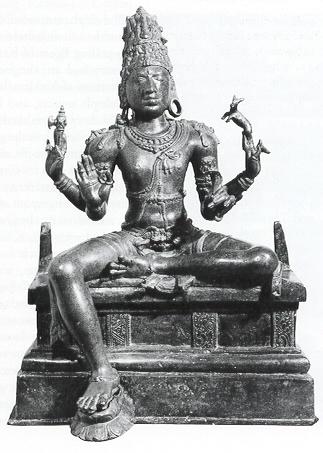
Among the primitive Indian boats, the cattarmaran comes first. It
consisted of three logs and three spreaders and cross lashings. The
centre log was the largest, and pointed towards one end. Mainly
fishermen used the cattarmaran for fishing. A little more skillfully
made is the musoola boat, which has no iron fastening. It was mostly
used in the Coromandel coast.
Dr John Fryer says,
"It is possible
that the name musoola may be connected with Masulipatarn where boats
seem to have been in use".
Another boat made in an indigenous manner was known as dingy. It was
hollowed out from a single trunk. Lower down the Ganga, the name was
applied to boats half-decked, half wagon-roofed and built of planks.
Purqoo was another type of boat described by Thomas Bowery. It plied
between the Hooghly and Balasore. These boats were made very strong
to carry ‘sufficient load’. They were also used for loading ships.
they could remain in water for a long time without getting damaged.
As compared to the purqoo, boora was a ‘lighter boat’ which rowed
with 29 or 30 oars. These boats were also used for carrying
saltpeter and other commodities.
(source:
Coastal trade flourished with Europeans - By Pramod Sangar).

Sir John Malcolm (1769 - 1833) was a Scottish soldier, statesman,
and historian entered the service of the East India Company wrote
about Indian vessels that they:
"Indian vessels are so admirably adapted to the purpose for which
they are required that, notwithstanding their superior science,
Europeans were unable, during an intercourse with India for two
centuries, to suggest or to bring into successful practice one
improvement."
(source: Journal of Royal Asiatic Society, Vol. I and India and
World Civilization - By D P Singhal part II p. 76 - 77).
In the middle of the 18th century, John Grose noted that at Surat
the Indian ship-building industry was very well established, indeed,
“They built incomparably the best ships in the world for duration”,
and of all sizes with a capacity of over a thousand tons. Their
design appeared to him to be a “a bit clumsy” but their durability
soundly impressed him. They lasted “for a century”.
Lord Grenville mentions, in this connection, a ship built in Surat
which continued to navigate up the Red Sea from 1702 when it was
first mentioned in Dutch letters as “the old ships” up to the year
1700.” Grenville also noted that ships of war and merchandise “not
exceeding 500 tons” were being built” with facility, convenience and
cheapness” at the ports of Coringa and Narsapore.
Dr. H. Scott sent samples of dammer to London, as this vegetable
substance was used by the Indians to line the bottom of their ships;
he thought it would be a good substitute,
“in this country for the
materials which are brought from the northern nations for our
navy…There can be no doubt that you would find dammer in this way an
excellent substitute for pitch and tar and for many purposes much
superior to them.”
source: Decolonizing History: Technology and Culture in India, China
and the West 1492 to the Present Day - By Claude Alvares p. 68-69).
Alain Danielou (1907- 1994) son of French aristocracy, author of
numerous books on philosophy, religion, history and arts of India
has written:
"India's naval dockyards, which belonged to the state, were famous
throughout history. The sailors were paid by the state, and the
admiral of the fleet hired the ships and crew to tradesmen for
transporting goods and passengers. When the British annexed the
country much later on, they utilized the Indian dockyards - which
were much better organized then those in the West - to build most of
the ships for the British navy, for as long as ships were made of
wood."
(source:
A Brief History of India - By Alain Danielou p. 106).
"...an Indian naval pilot, named Kanha, was hired by Vasco da Gama
to take him to India. Contrary to European portrayals that Indians
knew only coastal navigation, deep-sea shipping had existed in
India. Indian ships had been sailing to islands such as the Andamans,
Lakshdweep and Maldives, around 2,000 years ago. Kautiliya's
shastras describe the times that are good and bad for seafaring. In
the medieval period, Arab sailors purchased their boats in India.
The Portuguese also continued to get their boats from India, and not
from Europe. Shipbuilding and exporting was a major Indian industry,
until the British banned it. There is extensive archival material on
the Indian Ocean trade in Greek, Roman, and Southeast Asian
sources."
(source:
History of Indian Science & Technology).
India became the first power to defeat a European power in a naval
battle - The Battle of Colachel in 1742 CE.
A dramatic and virtually unknown past, in an area of bucolic calm
surrounded by spectacular hills: that is Colachel, a name that
should be better known to us. For this is where, in 1741, an
extraordinary event took place -- the Battle of Colachel. For the
first, and perhaps the only time in Indian history, an Indian
kingdom defeated a European naval force.
The ruler of Travancore,
Marthanda Varma, routed an invading Dutch fleet; the Dutch
commander, Delannoy, joined the Travancore army and served for
decades; the Dutch never recovered from this debacle and were never
again a colonial threat to India.
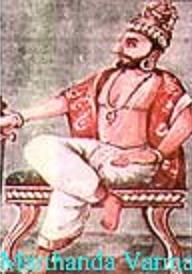 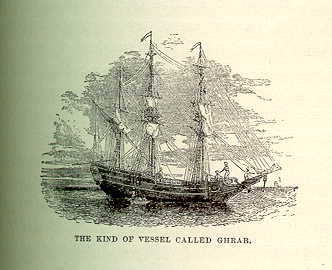
The ruler of Travancore, Marthanda Varma, routed an invading Dutch
fleet;
the Dutch commander, Delannoy, joined the Travancore army and
served for decades;
the Dutch never recovered from this debacle and
were never again a colonial threat to India.
The Battle of Colachel in 1742 CE, where
Marthanda Varma of
Travancore crushed a Dutch expeditionary fleet near Kanyakumari. The
defeat was so total that the Dutch captain, Delannoy, joined the
Travancore forces and served loyally for 35 years--and his tomb is
still in a coastal fort there. So it wasn't the Japanese in the
Yellow Sea in 1905 under Admiral Tojo who were the first Asian power
to defeat a European power in a naval battle--it was little
Travancore.
The Portuguese and the Dutch were trying to gain
political power in India at that time. Marthanda Varma defeated the
Dutch in 1741. He was an able ruler. He established peace in his
country - Travancore. It was a remarkable achievement for a small
princely state.
(source:
The Battle of Colachel: In remembrance of things past - By
Rajeev Srinivasan - rediff.com and
http://www.kerala.com/kera/culture1.htm).
Back to Contents
Diplomacy and
War
Not withstanding the elaborate rule of war laid down in the epics
and the law-books, insisting in the main that to wage war was the
duty and privilege of every true Ksatriya, in several cases the
horrors of war made the belligerent think of the consequences and
avoid outbreak of hostilities by a well calculated policy which we
now term diplomacy.
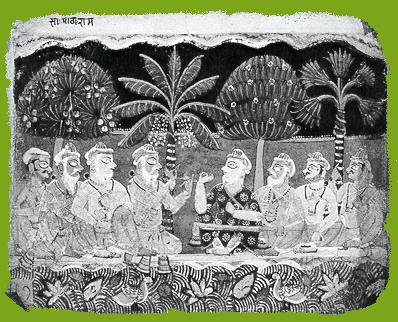
King seeking counsel.
Negotiation, persuasion and conciliation were cardinal points of the
ancient Indian diplomatic system, and were effective instruments in
averting many a war, which would otherwise have realized in much
bloodshed and economic distress.
The political term for diplomacy is naya, and the opinion of
Kautalya, the eminent politician of the 4th century B.C., a king who
understands the true implications of diplomacy conquers the whole
earth.
The history of diplomacy in ancient India commences with the Rig
Veda Samhita, and the date of its composition may be taken as far
back as the Chalcolithic period. In the battles the help of Agni is
invoked to overcome enemies. He is to be the deceiver of foes. In
pursuing his mission to a successful end, the use of spies is
mentioned. This bears eloquent testimony to the system of espionage
prevalent so early as the time of the Rig Veda Samhita. In the
battle of the Ten Kings described in the seventh mandala, we find
diplomacy of rulers getting supplemented by its association with
priestly diplomacy, which exercised a healthy influence on the
constitutional evolution.
International Relations - The picture presented in the epics and the
Arthasastra literature seems to be confined to the four corners of
Bharatkhanda. The intercourse as envisaged in the literature, shows
relations to be more commerical than political in character.
Strabo quotes Megasthenes and says that Indians were not engaged in
wars with foreigners outside India nor was their country invaded by
foreign power except by Hercules and Dionsysius and lately by the
Macedonians. There were friendly relations of Chandragupta with
Seleukos Nikator, of Bindusara with Antiochus, of Asoka and
Samadragupta with Lanka, of Pulaskesi with Persians, of Harsha with
Nepal and China, of the Cholas with Sri Vijaya.
"It was always regarded as a legitimate object of the ambition of
every king to aim at the position of Cakravartin or Sarvabhuuma
(paramount sovereign or of supreme monarch)."
This ambition was
legitimate and had no narrow outlook about it. It was a fruit to be
sought after by every one of the monarchs comprising the mandala. If
the king is not actuated by this idea, he falls short of an ideal
king according to the Hindu Rajadharma.
Diplomatic agents - ambassadors
Bhisma mentions seven qualifications as essential in an ambassador:
he should come from a noble line, belong to a high family, be
skilful, eloquent of speech, true in delivering the mission, and of
excellent memory.
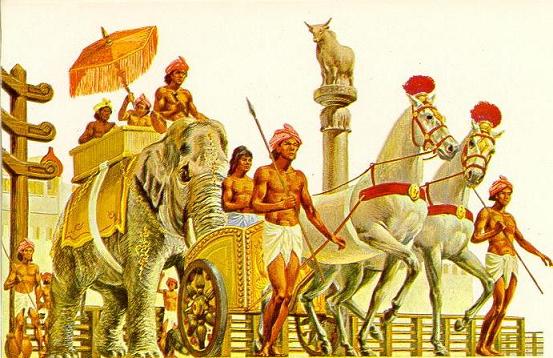
Espionage in War
Spies filled an important role in both the civil
and military affairs of ancient India. The institution of spies had
a greater utility, as the king could take action on the report of
the spies. Spies were engaged to look after the home officials,
including those of the royal household as well as to report on the
doings in the enemy kingdoms. The Rig Veda Samhita, often speaks of
spies (spasah) of Varuna.
Only men of wisdom and purity were sent on
this errand, thus suggesting that they should be persons above
corruption and temptation of any sort. In the epics and post-epic
literature in general, spies have been described as the 'eyes of the
king'. In the Udyoga-parva (33, 34) of Mahabharata, it is stated
that "cows see by smell, priests by knowledge, kings by spies, and
others through eyes."
Spies roamed about in foreign states under
various disguises to collect reliable information. In the Ramayana,
a king mentions the wise adage that "the enemy, whose secrets have
been known through espionage, can be conquered without much effort."
The Arthashastra, which predates Christ by centuries, dwells at
length on the importance of espionage and the creation of an
effective spy network.
Such details may indicate the high development of the science of
diplomacy in ancient India. It was the famous Indian strategist of
the fourth-century B.C, Kautilya in the Arthasastra, who gave the
world the dictum:
"The enemy of my enemy is my friend."
"The same style of Indian thought" says Heinrich Zimmer in his book,
Philosophies of India, p. 139, admiringly of Kautilya, "that
invented the game of chess grasped with profound insight the rules
of this larger game of power."
Attitude to war
The Sangam age of the Tamils was the heroic age of
the Tamil Indians. If the men of the Tamil land were heroes, then
their women were heroines. A certain mother was asked where her son
was, and she replied, that she was sure that the tiger that had lain
in her womb would be found in the field of battle. War was the
pabulum on which our ancient warriors were great in name and fame.
A
certain lady who gave birth to only one son and who sent him to the
field of battle when there was the country's call for it.
Okkurmasattiyar, a poetess, praises a certain lady dresses the hair
of her only son and gives him the armor to get ready for action in
the field of battle. This may be contrasted with another where a
heroic mother heard the disquieting news that her son lost his
courage in action and had fled in fear.
If it were true, she
expressed that she would cut off her breasts that had fed him with
milk. With this determination she entered the battle-field with
sword in her hand and went on searching for her fallen son. When she
saw her son's body cut in twain, she felt much more happy than when
she gave birth to him. (source: Puram 277 and 279 - in Tamil ).
Flags - The origin and use of flags can be traced to the earliest
Indian literature, the Rig Veda Samhita. The term deaja occurs twice
in the Veda. Besides, dhvaja, we meet with a good number of
expressions for a banner in Vedic literature. These are Akra,
Krtadhvaja, Ketu, Brhatketu, Sahasraketu. It appears that the Vedic
host aimed their arrows at the banners of the enemy.
The idea was
that once the banner was captured, or struck, a claim was made for
success in the battle over the enemy. Ketu was a small flag as
contrasted with Brhatketu or the big flag. Sahasraketu may be a
thousand flag, or as the knight who brought under control a thousand
flags of enemies. We are told that banners and drums were counted
among the insignia of ancient Vedic kings. In the Mahabharata war,
every leader had his own insignia to distinguish one division from
the other.
Arjuna had the Kapidhvaja or the flag with the figure of
Hanuman, Bhisma, Taladhvaja, cognizance of a palmyra tree etc..
Back to Contents
|

 forth his monkey hosts in quest of Sita.
forth his monkey hosts in quest of Sita. 









